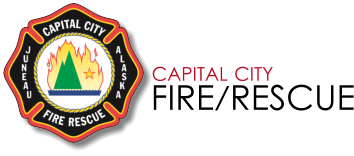History of Capital City Fire / Rescue

We are proud of our past and embrace our future
Our fire service history starts in 1881. Juneau was a mining camp of tents and rough wooden buildings perched above high tide at the foot of the mountains. The first residents were miners who came in open boats with their households on their backs. They knew how easily the fires that warmed them could be the destruction of their few possessions. By 1885, when mining operations had spawned a business community, wooden structures dotted the town site. Given the threat of loss of life or property to fire, in 1887 the Juneau Fire Association was the first organization founded in the isolated community and Herman H. Heart as Fire Chief.
 Emory Valentine, a local jeweler, founded the Hose Company Number #1 and Hook and Ladder Company #1. They ordered spiffy uniforms with red flannel shirts faced with black satin and adorned with brass buttons. A leather belt inscribed with Hose Number One and a blue cap adorned with a braided tassel and patent leather visor completed the example of a well-dressed fireman.
Emory Valentine, a local jeweler, founded the Hose Company Number #1 and Hook and Ladder Company #1. They ordered spiffy uniforms with red flannel shirts faced with black satin and adorned with brass buttons. A leather belt inscribed with Hose Number One and a blue cap adorned with a braided tassel and patent leather visor completed the example of a well-dressed fireman.
 At the turn of the 20th century fireman still hand pulled the heavy hose carts, often uphill and over planked streets. Given the climate of a rainforest normal dirt streets would have been impassable. The city council voted in 1913 to allow the use of horses to pull the heavy equipment as the distance within the town has become too great for hand pulling. Less than a year later, however, the council agreed to purchase Juneau’s first automated fire engines. The truck, a 40hp Stewart, with electric lights and a siren arrived in August 1914. It was a combination hose and chemical truck, caring and 80 gallon chemical tank with 300 feet of chemical hose and 800 feet of 2 1/2 inch firehose.
At the turn of the 20th century fireman still hand pulled the heavy hose carts, often uphill and over planked streets. Given the climate of a rainforest normal dirt streets would have been impassable. The city council voted in 1913 to allow the use of horses to pull the heavy equipment as the distance within the town has become too great for hand pulling. Less than a year later, however, the council agreed to purchase Juneau’s first automated fire engines. The truck, a 40hp Stewart, with electric lights and a siren arrived in August 1914. It was a combination hose and chemical truck, caring and 80 gallon chemical tank with 300 feet of chemical hose and 800 feet of 2 1/2 inch firehose.
World events brought many changes to the department through the years. In the summer of 1919, at end of World War I, the department purchased the LaFrance-Yablick smoke and gas mask for fireman. The facemask was attached to a canister that contained filters to remove smoke, gas, and ammonia from the air breathed in. Also purchased were six Sanderson Company protection helmets and along with them 10 rubber coats. The first turnouts were kept on the truck for use as needed by the volunteers.

Bill Roudolph
At the start of 1940’s with World War 2 and military service looming just around the corner for many of the members. With worry hanging over the small, isolated city with its young men off to war in Europe and Japan seeming so close there was still enthusiasm. The better than half of the department now consisted of newer members, a stronger effort was needed to train and develop a firefighting team. Specifications were developed for training and evaluating of volunteers on forcible entry techniques, use a breathing apparatus and increasingly technical firefighting tools and appliances, as well as basics such as ropes and ladders. In May 20, 1946 Bill Roudolf, died of injuries he sustained in a fall from a ladder when he attempted to help put out a fire after Perelle Apartments, this would be the fire departments first line of duty death.
In 1950 the City mayor was determined to put into service an ambulance for the ever growing community. He ordered the fire department and police department to work together to train and operate the communities first ambulance.
The 1970’s brought much change to Juneau. The towns of Juneau and Douglas, along with the other small communities in the area were incorporated within The City & Borough of Juneau. The population had burst out of the limits of the downtown district and by this time the City and Borough had five separate fire department operating; Juneau, Douglas, Glacier, Auke Bay and newly formed Lynn Canal Volunteer Fire Department.
For the better part of a decade the City and Borough operated with 5 separate combination or volunteer fire departments. Along with this came many challenges, with 5 different fire chiefs and 5 different ways of conducting operations. In 1990 the City & Borough set out to have a 3rd party independent study conducted to set a road map for the future of Juneau’s fire service. In 1992 under the newly hired Fire Chief Larry Lundfelt, a new fire department was created, Capital City Fire and Rescue. All the fire departments in the area were now under one umbrella. The rode was rocky and change was hard to accept but the decision to unify the department was made to better serve the greater community.
 We have had a several fire chiefs since the unification of the department. In 1998 Chief Michael Doyle replaced Chief Lundfelt and served CCFR for 6 years followed by Chief Eric Mohrmann for 6 years. In 2010 Chief Rich Etheridge was hired, Chief Etheridge was born and raised in Juneau. He served as an Alaska State Trooper and Juneau’s Fire Marshal before becoming the current Fire Chief.
We have had a several fire chiefs since the unification of the department. In 1998 Chief Michael Doyle replaced Chief Lundfelt and served CCFR for 6 years followed by Chief Eric Mohrmann for 6 years. In 2010 Chief Rich Etheridge was hired, Chief Etheridge was born and raised in Juneau. He served as an Alaska State Trooper and Juneau’s Fire Marshal before becoming the current Fire Chief.
The future is bright for us here in the Capital of Alaska, the department now has 36 career firefighters, 9 administrative staff and about 40 volunteers. CCFR has seen historic call volume increase within the last few years, 2016 we responded to 4,517 calls and we are on pace to top 5,000 for 2017.
Excerpts taken from:

Running Towards The Fires (101 years of the Juneau Volunteer Fire Department)
By Sandy Harbanuk
History of Juneau Fire Chiefs
Juneau Fire Association
1887-1896 Fire Chief Herman H. Hart
Juneau Fire Department
1896-1906 Fire Chief Emory Valentine
1906-1910 Fire Chief Thomas Foster
1910-1914 Fire Chief Milton Winn
Juneau Volunteer Fire Department
1914-1921 Fire Chief Sim Feiman
1921-1935 Fire Chief Dolly Gray
1935-1945 Fire Chief Penny Mulvihill
1945-1960 Fire Chief A. Minnard Mill
1960-1969 Fire Chief John Morrison
1969-1980 Fire Chief Douglas Boddy
1980-1990 Fire Chief Alan Judson
1990-1991 Fire Chief Larry Fanning
Capital City Fire / Rescue
1991-1998 Fire Chief Charles Lundfelt
1998-2004 Fire Chief Michael Doyle
2004-2010 Fire Chief Eric Mohrmann
2010- Fire Chief Rich Etheridge

